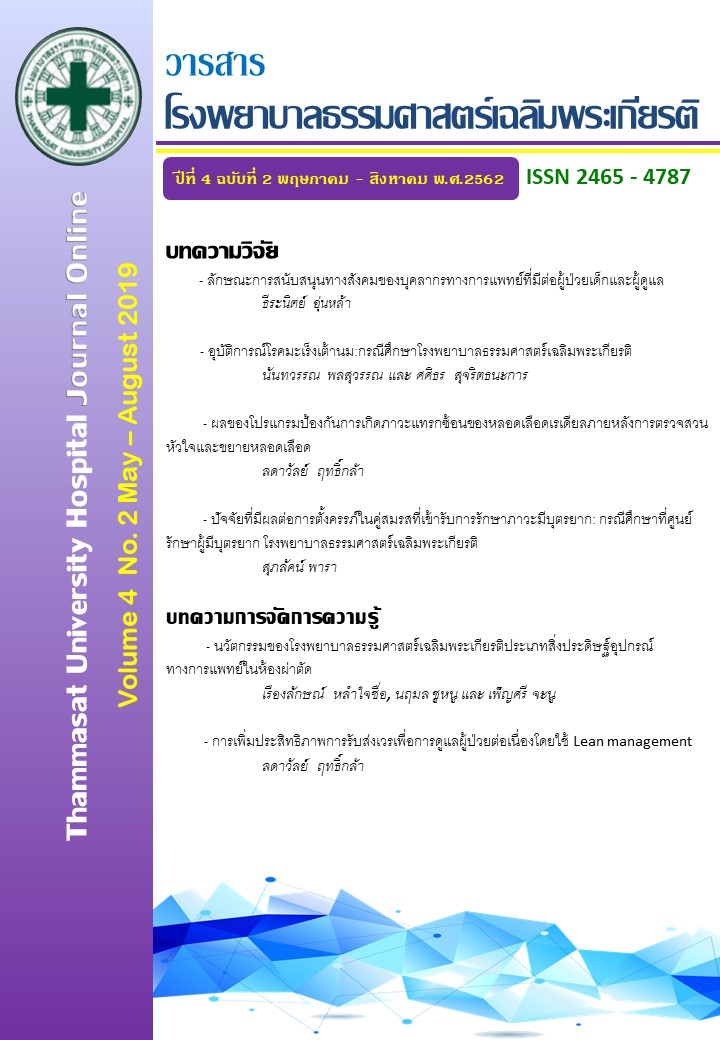Effects of a program to prevent radial vascular complications after Coronary Artery Angiography
Keywords:
Coronary angiography, radial vascular complications, prevention, satisfactionAbstract
Background: Coronary angiography are important tool for diagnosing and treating coronary artery disease, but complications may occur.
Objective: The purpose of this quasi-experimental research is to explore the effects of
short-term prevention of complications entrance wound catheter (access site) after coronary angiography.
Material and methods: A quasi-experimental study with a control group of patients after radial coronary angiography, who were admitted in Thammasat university hospital during July- December, 2018. Subjects were randomly assigned to the experimental group and control groups (30 patients per group). The experimental group received nursing care according to the evidence based practice model whereas the control group received usual nursing care. The number of patients who had short-term prevention complications from coronary angiography; hematoma, significant bleeding at access site, pseudoaneurysm was recorded. Satisfaction scale was developed and collected by the author. Data were analyzed using descriptive statistics, Chi-square test and independence t-test.
Result: During the July - December 2561, 60 patients were admitted for coronary angiography and percutaneous coronary intervention(PCI). Recording short-term complications, between the two groups was not statistically difference. While satisfaction was significantly higher in the intervention group.
Conclusion: The nursing practice guideline in patient leads to systematic approach patient care and increase level of patient satisfaction.
References
Hemingway H., McCallum A, Shipley M, Manderbacka K, Martikainen P, Keskimäki I. Incidence and prognostic implications of stable angina pectoris among women and men. JAMA. 2006; 295: 1401-11.
Centers for Disease Control. Coronary Artery Disease (CAD). 2015. Available from: https://www.cdc.gov/heartdisease/coronary_ad.htm.
McCabe P, A McPherson L, M Lohse C, Weaver AL. Evaluation of nursing care after diagnostic coronary angiography. AJCC. 2001;10:330-40.
Soukup SM. The Center for Advanced Nursing Practice evidence-based practice model: promoting the scholarship of practice. The Nursing clinics of North America. 2000;35:301-9.
Craig Jean, Smyth L Rosalind. The evidencebased practice manual for nurses: Churchill Livingstone; 2002. Available from: https://www.elsevier.com/books/the-evidence-based-practice-manual-for-nurses/craig/978-0-7020-4193-8
Joanna Briggs Institute [JBI]. JBI Levels of Evidence and Grades of Recommendation. 2013. Available from: https://joannabriggs.org/jbi-approach.html#tabbed-nav=Levels-of-Evidence.
Melnyk BM, Fineout-Overholt, Stillwell SB, Williamson KM. Evidence-based practice step by step: Critical appraisal of the evidence: part I. AJN. 2010;110: 47-52.
John P. Harper. Post-Diagnostic Cardiac Catheterization Development and Evaluation of an Evidence-Based Standard of Care. JNSD. 2007;6:271-6.
สำนักงานสถิติแห่งชาติ. สถิติสาธารณสุข ปี 2560. 2560. เข้าถึงได้จาก: https://bps.moph.go.th/new_bps/sites/default/files/health%20stratistic%202560.pdf.
Ahmed Bina, Piper D. Winthrop., Malenka David, VerLee Peter, Robb John, Ryan Thomas, et al. Significantly improved vascular complications among women undergoing percutaneous coronary intervention: a report from the Northern New England Percutaneous Coronary Intervention Registry. JACC. 2009;5:423-9.
Duvernoy S. laire, Smith E. Dean, Manohar Prerana, Schaefer Ann, Eva Kline-Rogers, Share David, et al. Gender differences in adverse outcomes after contemporary percutaneous coronary intervention: an analysis from the Blue Cross Blue Shield of Michigan Cardiovascular Consortium (BMC2) percutaneous coronary intervention registry. AHJ. 2010;4:677-83.
Mrdovic I, Savic L, Krljanac G, Asanin M, Lasica R, Djuricic N, et al. Simple risk algorithm to predict serious bleeding in patients with ST-segment elevation myocardial infarction undergoing primary percutaneous coronary intervention: RISK-PCI bleeding score. JACC 2013:1719-27.
Rolley X John, Davidson M Patricia, Salamonson Yenna, Fernandez Ritin, Dennison R Cheryl. Review of nursing care for patients undergoing percutaneous coronary intervention: a patient journey approach. JCN 2009; 18: . 2009;18:2394 -405.
Doyle J. Brendan, Ting H. Henry, Bell R. Malcolm, Lennon J. Ryan, Mathew Verghese , Singh Mandeep, et al. Major femoral bleeding complications after percutaneous coronary intervention: incidence, predictors, and impact on long-term survival among 17,901 patients treated at the Mayo Clinic from 1994 to 2005. JACC 2008;1:202
Levine N. Glenn, Bates R. Eric, Blankenship C. James, Bailey R. Steven, Bittl A. John, Cercek Bojan , et al. ACCF/AHA/SCAI Guideline for Percutaneous Coronary Intervention: a report of the American college of Cardiology Foundation/ American Heart Association Task Force on Practice Guidelines and the Society for Cardiovascular Angiography and Interventions. JAHA 2011; 23: . 2011;124(23):574-651.
Rolley X John, Davidson M Patricia, Salamonson Yenna, Fernandez Ritin, Dennison R Cheryl. Review of nursing care for patients undergoing percutaneous coronary intervention: a patient journey approach. JCN 2009; 18: 2009;18:2394 - 405.



